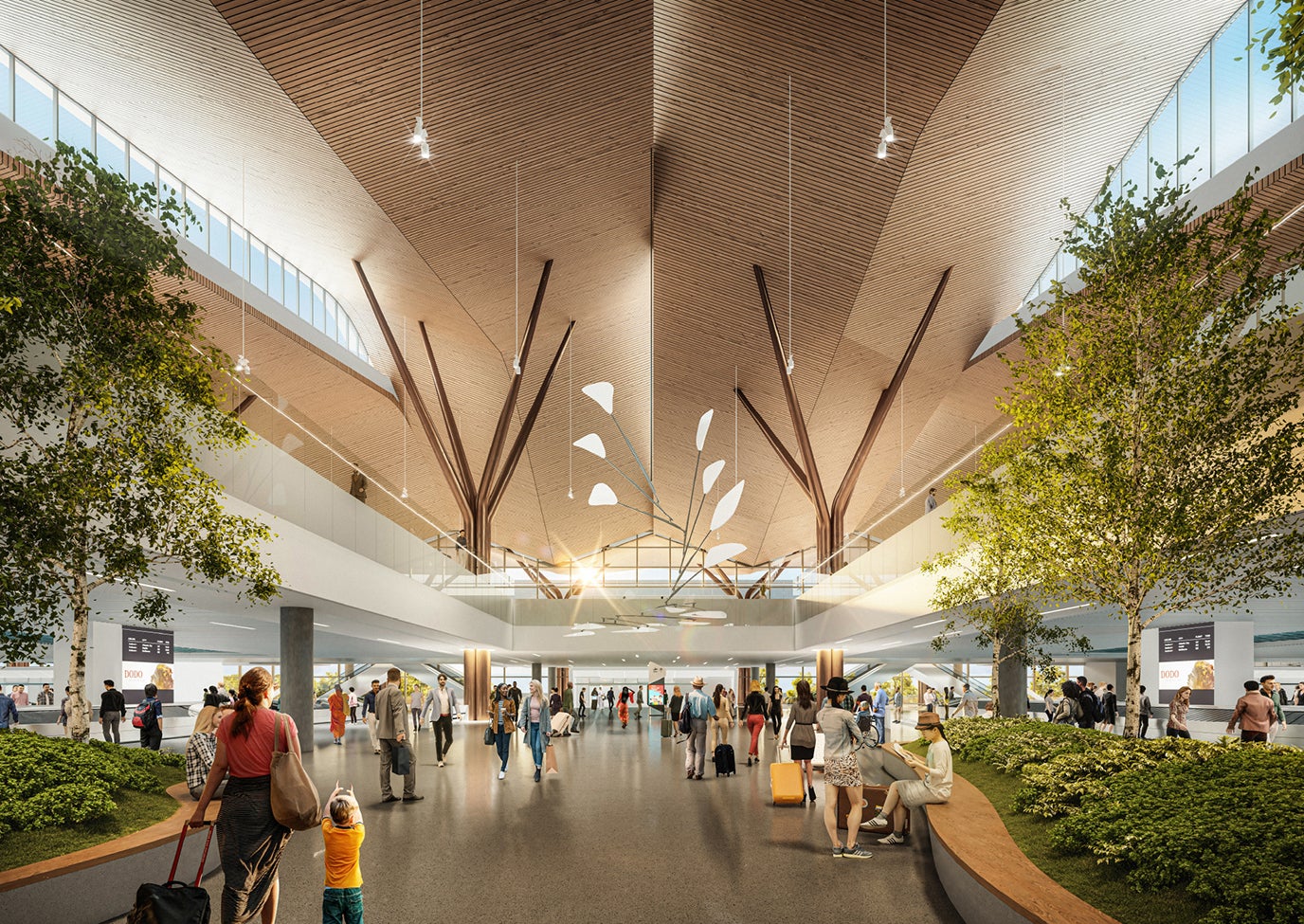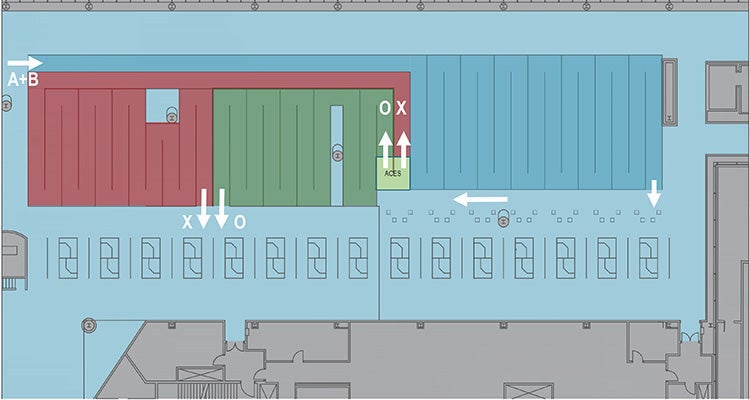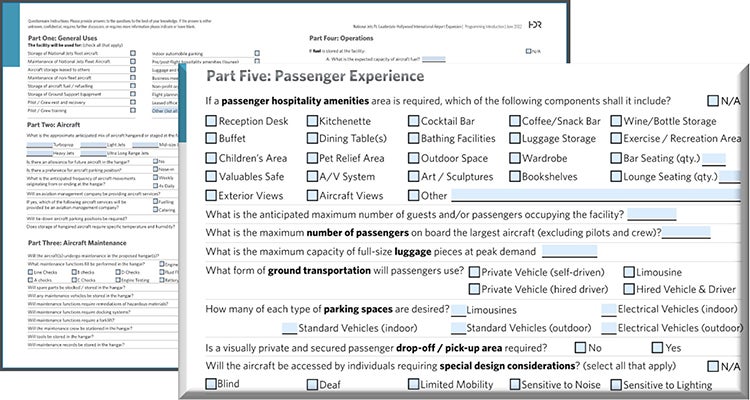
Experts Talk: Pragmatic Design of Airport Terminals with Robert Feteanu
Experts Talk is an interview series with technical leaders from across our transportation program.
Addressing Trends of Increased Aviation Demand and Changing Passenger, Stakeholder and Operational Expectations With an Integrated Approach
Airports are vital hubs for moving people and goods around our interconnected world. They are complex systems — in some ways like a small city — that face everyday challenges of growing demand and changing expectations on the part of the travelling public. At the same time, cities seek to develop their airports as attractions or destinations, and as gateways that express the personality of their city.
In this interview Robert Feteanu, our Canadian aviation lead and a global aviation strategic advisor, shares his thoughts on how pragmatic design of airport terminals serves the global aviation industry today. Feteanu has a deep understanding of airports, particularly terminal functional programming and passenger processing. He has acted as technical lead and project manager for space programming, airport simulation and traffic analysis for some of the biggest airport developments around the world, including Changi Terminal 5 in Singapore, Hamad International in Doha, Taipei Terminal 3 in Taiwan, and the New Midfield Terminal in Abu Dhabi.
He explains how he applies a pragmatic approach to terminal design, using principles of functional planning, to address each airport’s needs and growth challenges to guide decisions on capacity investments.
Q. Pragmatic design may be an unfamiliar term for some. What do you mean by that when it comes to airports?
A. Pragmatic design, at its core, means we recognize that each facility is unique, and we design improvements that reflect those differing requirements, stakeholders and opportunities. What do I mean by that? In my experience, it means designing for the airport and passengers we have today and expect in the future, not just designing to mimic other airports.
It means designing a hub airport (where more than 50% of passengers are there to change flights) differently than an origin-destination or OD airport (where most passengers are actually to/from). It means an airport in a major Asian city will look different than a similar size airport in North America. It considers all the spaces — public spaces for passengers as well as back-of-the house support spaces — in one coherent programmatic approach.
Passenger satisfaction is an important consideration, particularly because different passengers have different expectations. Business travellers want a lounge to work in, want to efficiently get to meetings, and maybe want a refreshing shower after a long-haul trip.
Charter or family travellers have very different expectations; their vacation starts when they get to the airport so they may be less hurried, have children in tow and value amenities. A growing category is low-cost passengers who look for inexpensive flights and go on “city breaks” for a weekend.
Pragmatic design considers the spaces that support the passenger experience of these various traveller categories based on the mix for that airport.

We also address the unseen support spaces which can occupy as much as half of a terminal’s square footage. An airport terminal is a very complicated building, dependent on complex supporting systems from cargo and baggage handling to maintenance and MEP (mechanical-electrical-plumbing).
We can’t just focus on the public areas that passengers experience directly because these vital supporting systems occupy significant space. Using a pragmatic approach during early functional planning of a terminal, we think through where to place these critical support areas and how to efficiently integrate them into the design.
Successful designs will balance the needs of the various categories of passengers with the requirements of stakeholders who rely on support areas for carrying out airport operations.
Q. If the core of pragmatic design lies in addressing the unique needs of each facility, how do we thoroughly analyze and understand the specific needs of each airport?
A. We know world population is growing and the world is increasingly interconnected; air travel is expected to double in the next 25 years. If we do a straight extrapolation based on how we travel now, the infrastructure can’t keep up.
To plan and design spaces appropriate to these demands in each airport we run complex capacity demand analysis and passenger flow simulation models that allow us to understand the entire airport, from curb to gate and back. Such models help us focus on constraints.
For example, if we upgrade the security checkpoint to flow more quickly we may find more passengers congregating near the gates so we’d want to rethink those areas to evaluate amenities, hold rooms and gate access. These analyses allow designers and stakeholders to run what-if scenarios which support thoughtful discussions to evaluate proposed changes.

Airlines and airplane manufacturers have already started addressing increased air travel demand by designing high density aircraft that deliver more passengers to the terminal using the same runway and apron space. Aircraft such as the A320neo or B737Max now come to the gate with 30% more people than previous models. Serving these aircraft means that the building suddenly has 30% more people within the same space, which means we need to think about hold rooms differently.
U.S. airports have traditionally had airline-dedicated gates and hold rooms, which are less flexible than common-use areas designed to “dwell anytime, anywhere” based on traffic demands. By making the hold room a larger common space with easy access to gates, and thinking about which amenities are needed, we distribute the demand in the space and thus can accommodate more people within the same footprint.
Q. Once the needs are clear, how does a pragmatic approach help prioritize decisions?
A. Terminals must balance the interests and needs of stakeholders ranging from airlines to government agencies to back-of-the-house operations to concessionaires. There are several well-known tools in the field that we use for the analyses I just described, but the important thing is the clarity and thoughtfulness of the inputs — the discussion with stakeholders and the insight into the inputs and interpretation of the model results.
Pragmatic design is different by type of airport and its clients. For example, for passengers transitioning at a hub airport we would focus on connect time and transfer passenger processes and amenities. Different amenities are attractive to the long-haul transfer passenger such as a place to nap in a quiet zone, a place to catch up on email, mini gardens or pet exercise areas that bring the outside inside, shopping. Hub airports are more like a transit hub where we think about dwell time and efficient transitions. We focus planning with stakeholders — concessionaires, carriers, developers — on how to make the most of the passenger connection experience in these hub situations.
Each airport has many stakeholders with different interests. The pragmatic design incorporates all stakeholders’ perspectives into one solution within constraints of schedule and funding — the approach considers everything from infrastructure to passenger.

Q. How does this pragmatic approach extend to developing landmark airports that also serve as attractions?
A. In many cities across the world, airports are used not just as logistical centres, but also as destinations and tourism generators in themselves.
In the past 20 years many global cities have pro-actively built world-class airports in advance of the demand and have seen those airports become landmark attractions to improve their city. Examples include Hong Kong, Singapore Changi, Dubai International and Doha Hamad. U.S. and European airports are now investing to match the level of the newer airports in the Middle East and Asia, accelerating architecture, engineering and customer satisfaction improvements.
An airport is the front gate of a city — it’s what you will remember of the city whether it’s your destination or you are just passing through. Let’s say you transfer in Doha — you see city images and museum exhibits in the airport and you’re intrigued, so maybe next time you travel through you will schedule a longer visit.
In Changi, for example, the airport brands itself as a destination and even their connecting traffic is more than 70% long connects (transfers with more than 3 hours between flights). Therefore they designed facilities that will keep passengers entertained and relaxed during that time, ranging from an incredible retail offering such as The Jewel entertainment and retail complex, to lots of in-terminal relaxation zones. Their goal is not only to help airline passengers feel as if they have visited Singapore during their connection, but even to attract people who aren’t even flying to visit The Jewel for shopping and entertainment.

Q. Passenger satisfaction is very important, but so is freight, and airports are vital movers of cargo. How should goods movement affect how we think about airport design?
A. The pragmatic design approach recognizes that cargo is also an important aspect of airport operations and therefore must be addressed for effective design. One typically thinks first of dedicated cargo carriers and planes which typically operate in a dedicated area of the airport with specific airside/landside warehousing, loading docks and so on.
Then we have cargo carried in passenger aircraft, which we call belly cargo. Passenger bags typically occupy only limited space in the belly of the widebody aircraft — the rest is cargo. We saw that when we started cancelling flights during the COVID-19 pandemic we couldn’t move cargo through those means, which impacted the global supply chain.
So if I’m an airport operator, I have to think about belly cargo with respect to my airport’s operations and airplane turnaround. This means we think about the apron design to program spaces for loading/unloading, trucking and warehousing of cargo. We may have stakeholders who require internal spaces for inspection or screening, or for automated cargo handling.
We call these the ”below the wing” terminal support areas and find that the best functional designs address their requirements early on in functional planning to provide well-designed support spaces for ground handlers and cargo operations. Those are stakeholder spaces and staff that a passenger never sees or interacts with, but they need to be integrated into the design.
Advice and Inspiration
Q. How did you get started in airport terminal design?
A. By training I am an aerospace engineer, so I’ve always liked airplanes and living in the future. After moving to Canada and finishing my master’s degree in solid-propellant rocket motors I faced an interesting turning point in life. I was accepted for a PhD program at the University of Alabama in Huntsville where I would have been involved with NASA Marshall Space Flight Center for the Moon, Mars and Beyond program; at the same time I received a job offer as an airport consultant, focusing on airport planning, analysis and simulation, with my first assignment being the New Midfield Terminal in Abu Dhabi. I chose the consultant opportunity and after a few weeks on the job I knew I was fascinated by the complexity and excitement of the airport world and decided that this is the career I want.
From there, it was one assignment after another for world-class, landmark projects such as Doha, Dubai, Incheon, Taipei, New Istanbul and Singapore, to name a few. I think this demonstrates how powerful our on-the-job project experience can be in shaping our career opportunities.
Q. What advice do you have for early-career professionals in aviation?
A. In my view, it’s very impactful to be exposed to interesting and challenging projects in early-career work assignments. I think we want junior people to be on challenging and demanding projects, not boring tasks, to expose young people to exciting work. I was lucky to work on a five-star airport from the first day and it captured my imagination, so I try to offer similar opportunities to all members of my team, regardless of their seniority. I’m excited to continue delivering world-class aviation projects here at HDR.
If you are in the world of aviation you’re in the right field. It’s a growing field, capacity is needed. Once you visit an airport you realize that each is so different from the other. You don’t copy and paste.
Aviation is global and not local. A career in aviation requires understanding trends around the world. That means that aviation professionals are always designing something new in different parts of the world, and not necessarily in the city they are based in. This makes aviation exciting, challenging and never boring.
Each Experts Talk interview illuminates a different aspect of transportation infrastructure planning, design and delivery. Check back regularly for new insights from the specialized experts and thought leaders behind our award-winning, full service consulting practice.




